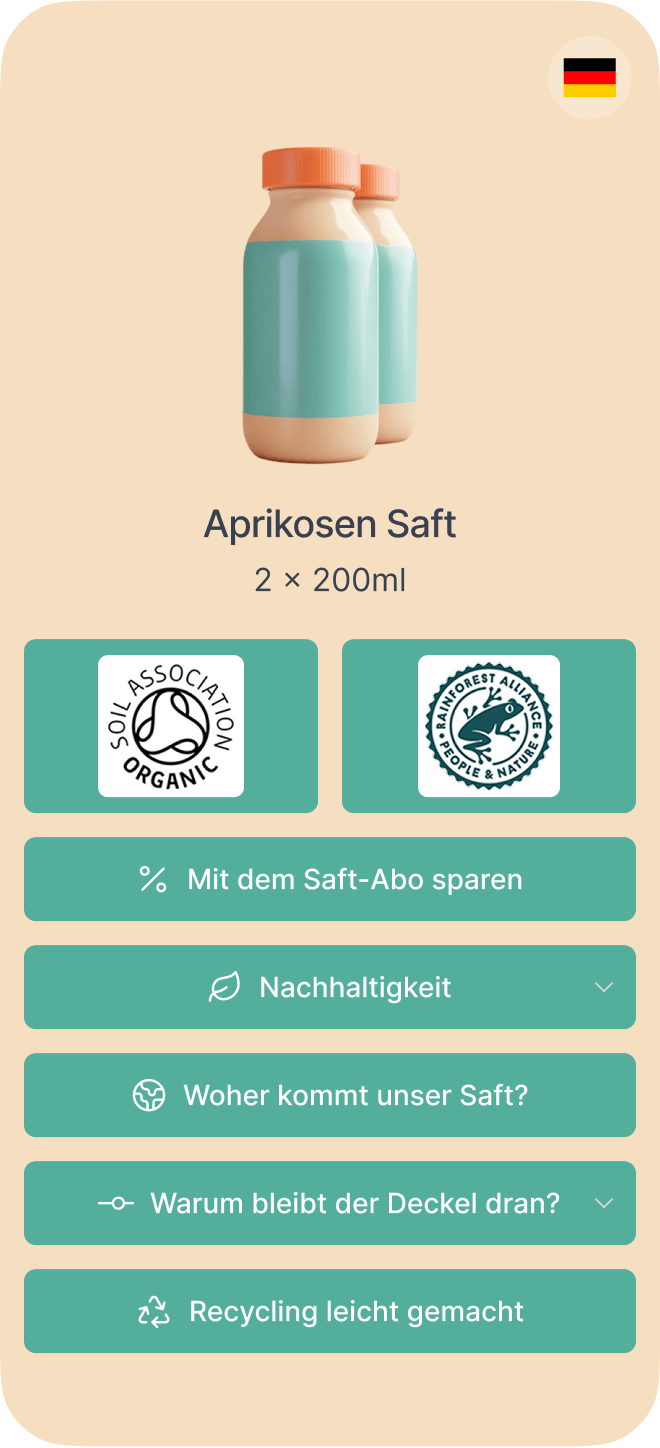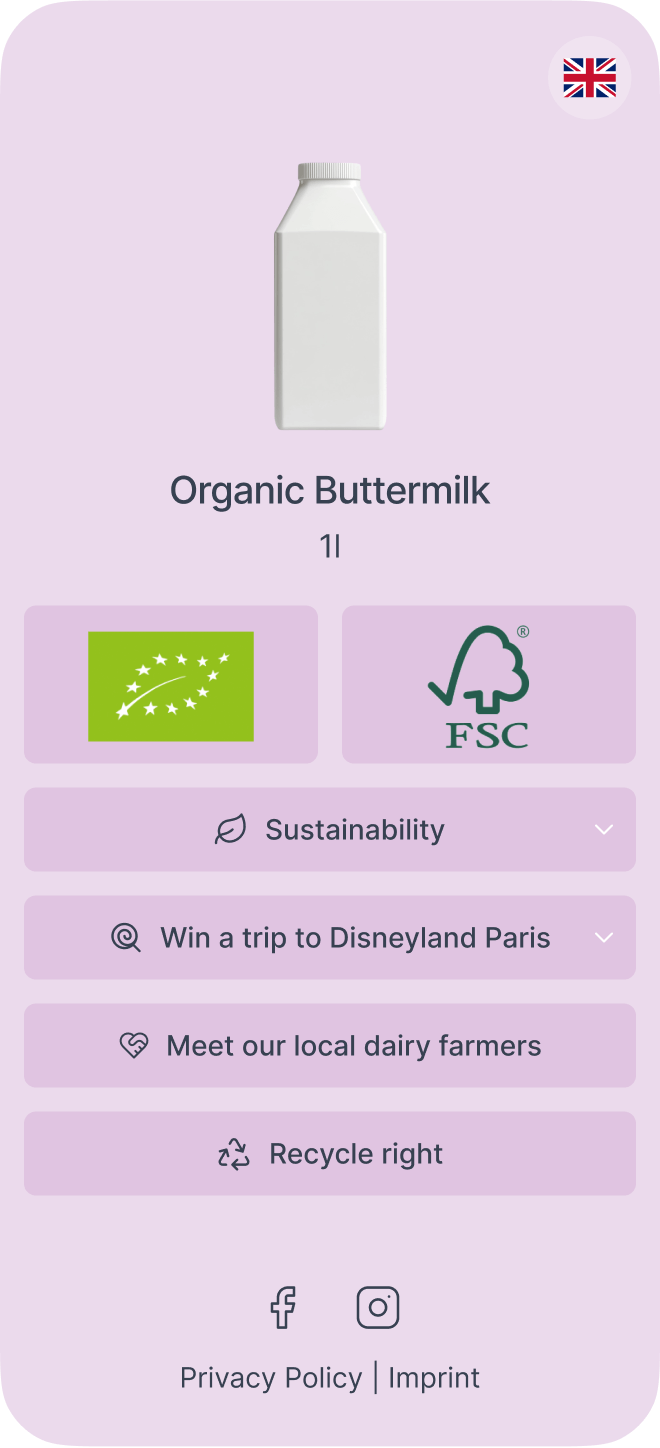QR Code on Packaging: Which product information can be digital?

The consumer goods sector is witnessing a significant shift with the integration of QR codes on product packaging. This change is prompting essential questions about the kind of information these codes can convey and what information must be physically present on the products. This article discusses the regulatory implications and practical aspects of utilising QR codes for sharing product information with consumers, particularly focusing on QR code packaging and QR code product information.
QR Codes and Consumer Product Information on Packaging
Consumers traditionally received product information directly from labels or printed packaging. QR codes represent a change, facilitating access to extensive data about the product, including usage instructions, environmental claims, or recycling information. This makes QR codes on product packaging an attractive solution for companies looking to provide comprehensive details.
However, a fully digital approach might exclude those without smartphone access, posing a question about which details companies can ethically place behind a QR code and what information must be readily visible to all consumers. The legal framework around this issue, particularly concerning QR codes on products and QR code requirements, is still developing due to the novelty of QR codes, with courts attempting to determine the extent of companies' obligations in this context.
Environmental Benefits vs Regulatory Implications of QR Codes on Packaging
One of the compelling arguments for QR codes on packaging is their potential to reduce paper waste by transitioning to digital user manuals and other documents, a notion supported by a 2014 court case that validated supplying a digital camera's manual via a CD. The decision underscored that even technology with less than universal accessibility could be an acceptable platform for providing information. This highlights the potential of QR packaging for sustainability.
However, the increasing reliance on QR codes on product packaging comes with regulatory challenges, particularly concerning consumer protection laws. If crucial safety information is only available through a QR code, it could impinge on the rights of those without smartphones or familiarity with this technology. This raises concerns about product qr codes and accessibility.
The German Product Safety Law (ProdSG) emphasises that products must not present any health or safety hazards with typical usage and demands user manuals in German upon a product's market entry. Yet, the law does not address the specific format of these instructions, leaving a gray area in terms of digital versus printed guidance regarding QR code product information. However, platforms like the leading compliant digital label platform info.link help companies bridge this gap by providing a secure and regulation-ready way to deliver digital product information through QR codes while maintaining full accessibility for consumers.
Recent Court Decisions in Germany on QR Code Product Labeling
The interpretation of QR codes' legality and appropriateness in product labelling has been a subject of discussion in German courts. On July 6, 2023, the OLG Düsseldorf (Az. 20 U 152/22) endorsed the use of QR codes for additional information where space is limited, like magazine advertisements. However, this endorsement did not extend a universal application to all consumer goods packaging coding.
In agreement, the LG Stuttgart (Az. 53 O 169/22) ruled that essential product information must be physically present on packaging unless there are justifiable space limitations, highlighting that 21% of consumers cannot access digital data due to a lack of smartphones. This reinforces the need for careful consideration of which product information is placed behind a QR code.
On July 26, 2023, LG Karlsruhe (Az. 13 O 46/22 KfH) allowed the use of QR codes but mandated that packaging must make consumers aware of additional information available online. This ruling provides guidance on QR code rules for products with qr codes on the packaging.
A significant development occurred on May 23, 2023 (Aktenzeichen 312 O 126/22), with Beiersdorf AG committing to greater transparency in its advertising practices following an agreement with Deutsche Umwelthilfe (DUH). The firm consented to using QR codes or web links to provide in-depth information on their carbon offset initiatives, preventing potential legal penalties. This case demonstrates the growing importance of clear QR code for product communication.
The Future of QR Codes on Packaging in Light of Legal Interpretations
Perhaps the strongest indication for the expanding use of QR codes on packaging is at EU level, where new regulations indicate the EU’s openness to the use of QR codes to make crucial information accessible to consumers. This suggests a future where products with QR codes are increasingly common.
EU Regulatory Developments for QR Code Labeling
EU Regulation 2021/2117 permits wines and aromatised wine products to use digital "e-labels" for conveying ingredient and nutritional information, accessible via QR codes or links. This is a clear example of QR code labeling being integrated into specific product categories.
Another example is the new EU regulation for the digital labeling of fertilizers, adopted by the European Council on July 22, 2024, which allows suppliers to use digital labels like QR codes and barcodes to provide essential product information. This regulation aims to improve label readability and simplify requirements, reducing costs, bureaucratic barriers, and environmental impact. Despite the shift to digital solutions, physical labels remain mandatory to ensure accessibility for all consumers, especially those with limited digital access.
The digital labels link to comprehensive product information, which must be freely accessible for at least ten years, without requiring any login or password. For bulk goods, key information must be displayed both digitally and physically at the point of sale. The regulation, which aligns with EU practices for digital labeling in other sectors such as batteries, is expected to yield annual cost savings of around €57,000 for large companies and €4,500 for SMEs, as described in a post by the European Council. This further emphasizes the role of QR codes for products.
QR Code Requirements and Future Directives
Additionally, even though the EU Green Claims Directive may now have been postponed or even cancelled, its draft (Art. 5 (6)) gives a clear indication of the EU's understanding of leveraging QR codes to share product information:
Information on the product or the trader that is the subject of the explicit environmental claim and on the substantiation shall be made available together with the claim in a physical form or in the form of a weblink, QR code or equivalent.
The EU's Empowering Consumers Directive (Directive (EU) 2024/825) mandates that environmental claims on product packaging be substantiated with clear and accessible information. While the directive does not explicitly require QR codes, it emphasizes the need for transparency in green claims. In this context, incorporating a digital link – such as a QR code – on packaging is highly advisable. This approach aligns with recent legal interpretations, including a ruling by Germany's Federal Court of Justice concerning Katjes, where the court considered the availability of detailed information through digital means when assessing the validity of environmental claims.
Looking ahead, the forthcoming EU Digital Product Passport (DPP) initiative will necessitate the inclusion of standardized digital identifiers, like QR codes, on product packaging. These identifiers will provide comprehensive information about a product's sustainability, origin, and lifecycle. The GS1 Digital Link standard is poised to replace traditional barcodes, enabling a single QR code to serve both as a point-of-sale identifier and a gateway to rich digital content.
The Future of Product Information is Digital
In conclusion, while current legal positions show varying degrees of acceptance for QR code on product packaging, the trajectory indicates a growing inclination towards QR codes in product labelling. The ongoing challenge is ensuring this digital shift coincides with comprehensive consumer protection measures and accessibility, particularly when considering what information is appropriate to place on a product with QR code. Brands that proactively adopt these technologies can enhance consumer trust through increased transparency and position themselves advantageously in a market moving toward greater digital integration.
Platforms like the leading digital label solution info.link enable brands to make this transition seamlessly by offering a compliant and future-ready infrastructure for managing digital product information through QR codes — strengthening transparency and consumer trust in an increasingly digital marketplace.
Disclaimer: This article is for informational purposes only and does not constitute legal advice. Please consult a qualified legal professional for guidance tailored to your situation.
FAQFrequently Asked Questions
Author
Max Ackermann
Max Ackermann is Founder & CEO of info.link, a technology company based in Hamburg and Berlin, Germany. info.link helps brands turn products into smart, compliant digital touchpoints. Max has over 20 years of experience building digital businesses, leading McKinsey's Design and Corporate Venture teams across Europe. He has also built digital products and platforms with global brands like Nike, Google, Meta, and Airbnb. Max helps brands create GS1-standard Digital Labels to share Green Claims, Digital Product Passports, product information, promotions, and more. He is an expert in QR codes, green claims, EU regulations, multilingual digital labeling, and is a Fellow of the Higher Education Academy in the UK.


